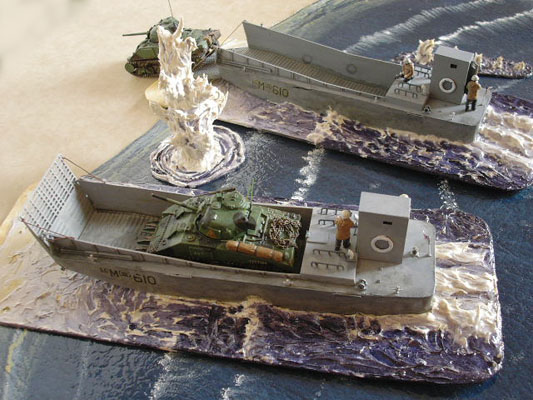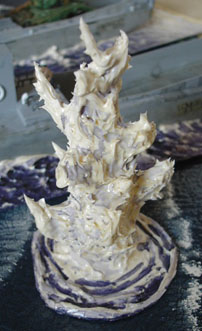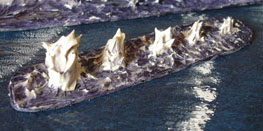IMPROVING AIRFIX LCMs

I had two old Airfix landing craft, made in my childhood. This was a common kit, that came with a Sherman tank. It wasn't very useful on the wargame table, though, because it was not a waterline model, and the LCMs (Landing Craft, Medium) looked a bit daft sitting beached with their rudders and propellers waving in the air. Then one fine day I was standing in a shop called Everything's a Pound, in which I saw mastic guns and their ammunition for an unsurprisingly cheap price, and I had an idea. Just in case you don't know what these things are, here is a picture:

|
They had both brown and white mastic. Brown I had already used when making roads and craters (see scenery section), but now a use for white occurred to me. Note that the particular sort of mastic is acrylic, because this takes paint, and not silicone mastic, which doesn't. I would supe-up my LCMs.
|

This is the result. The two landing craft are based on thick card, with rounded corners. The bases are covered with enough mastic to give the illusion that the craft have arrived in the shallows, and are ready to disembark their cargoes. First, I removed the propellers and rudders, and carved away all the detail on the bottoms of the models, and with a rasp flattened the bottoms as much as I could. I then got the mastic gun ready and used the mastic to glue the craft in place, and then squidged out lots more mastic all around it, and then with a small lollipop stick I sculpted the mastic into waves.

I read that landing craft often had to keep their propellers powering them forwards, in order to stop them from drifting back off the beach with each receding wave. This gave me an excuse to model deep ridges of mastic at the rear of the craft. This was useful because here the back of the model lifts high off the base, so took a lot of hiding. From memories of propeller washes, I modelled the parts of the sea immediately behind the two propellers as dips, and either side of these dips I raised round ridges of mastic, which I painted hardly at all. The dips I painted in a very pale wash of navy blue.
This picture also shows that the LCM is flying the white ensign, which I think is correct.

|
I wanted the doors to be hinged. Alas, childhood hamfistedness had rendered the original hinges inoperable, so I had to scratch build new hinges (which adult hamfistedness has already broken once). To make it possible to hold the doors in the up position, I added two little mushroom-shaped (a small disc on top of a small rod) bits on the tops of the sides of the craft, around which I could hook the threads of the door cables. This is not an authentic arrangement, but one which is not too fiddley to use on the wargame table.
|

|
Plan view of the bay and the two LCMs. The bay is made from a piece of leatherette (fake leather) which was navy blue to start with. I painted white waves on it, and a wash of sand to indicate the shallow strip along the edge where the waves met the beach. I made the waves on the bay match the waves on the bases of the LCMs, so that when in place, the LCMs fitted in happily. I had a rectangle of leatherette, and cut this bay from it. The other half of the leatherette was then painted in much the same manner to form the sea space around a promontory. The finished thing was gloss varnished, and has ever since proven a magnet for dust and hairs.
|
|
On the right, a close up of the big explosion. The base is a piece of card, onto which I have a stuck a wire skeleton of the explosion, which was bulked out with expanded polystyrene packing material. Over this I lavished lots of white acrylic mastic, which I flicked up into spikes with my mini-lollipop stick. Once set, I painted it with various dilutions of navy blue paint, and then gloss varnished.
Below, you see five diminishing splashes, to represent the effect of a burst from something like a Bofors gun. Again, the base is just card, and the splashes are mastic. Only the largest couple of splashes have anything to make up a core (a blob of cork). The others are just pure mastic.
|

|

|
WW2 VEHICLES MENU
BACK TO MODELLING MENU
Click here to go back to the home page
|







